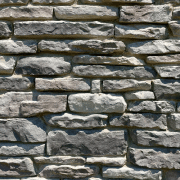Routinely Inspect Your Siding
Some homeowners might find themselves doing this without thinking, but performing a routine inspection a few times a year does a lot for your veneer. While you admire the beauty of your stone siding, you begin to familiarize yourself with the minor details and occasional imperfections. This is an especially important routine to take part in after a bad storm or another type of hazardous weather. While your siding is made of stone, which is a durable material, it is still fragile and prone to cracks and damage to its foundation.
In the worst-case scenarios, it’s possible for debris to damage and knock off panels of your siding. It is important to check other fixtures around your home to ensure there is nothing else awry with the foundation. Overall, what starts as a routine inspection of your siding is one for the rest of your home’s exterior. Taking pictures and reporting it as a result of natural weather conditions is also good for any potential insurance claims.
Avoid Strong Chemicals
For those who prioritize the color of their stone veneer siding, it’s important to understand the chemicals capable of harming the material you are washing. The process of cleaning your siding does not require heavy-duty cleaning solutions. Instead, it’s a good idea to use a simple mixture of vinegar and soap for most of your cleaning tasks. This naturally gentle combo is great for cleaning up anything left behind by animals or weather conditions.
When cleaning up something like a natural fieldstone veneer, regular care is necessary. For example, you should use a soft sponge when scrubbing. Alternatively, artificial materials such as cultured stone are best cared for with extra precaution. Damaging and wearing down the facade of this material reduces its expected life span. Also, this type of material can’t be repaired by the stone but rather by entire panels. To save the hassle, it’s best to be careful when washing it.
Use Gentle Cleaning Tools
Many people operate under the false assumption that they need a heavy-duty cleaning tool to get rid of any residue remaining on their veneer. Things such as wire brushes and other similar tools do no good when directly contacting the stone. Stone is a durable material, but once it is damaged to a specific degree, there is no saving it, and you’ll need to replace it.
Sponges and towels are the preferred methods when dealing with messes requiring hands-on cleaning. Not everyone is capable of getting into the higher locations of their home for cleaning. However, certain stone veneers created from authentic and natural stone sometimes have the option to be power washed instead. Comparing the two processes of power washing and hand washing, it’s easy to see which one most homeowners prefer. While it seems efficient, it is essential to understand that pressure washing your veneer more than likely accelerates the degradation process in most cases. Unless you know that yours is capable of withstanding one, it’s best to go with the classic method instead.
Repoint Your Crevices
Repointing your veneer means that you are occasionally putting on an additional layer of mortar between the stone pieces. As a result of being exposed to the elements regularly, the mortar that holds your stones in place is more likely to be susceptible to damage and wear before your veneer. To help keep things secure, it is best to repoint your veneer when you first notice damage on your siding.
Other repointing methods include cutting out damaged sections of your veneer and filling them with mortar. While it sometimes feels bothersome to recreate the mix, this task is necessary to maintain your veneer for as long as possible. For the optimal confirmation level, it’s best to let your work rest overnight and check it the following day. From there, you can completely seal any cracks that you can still see until the next time you need to repair the veneer.
Apply Sealant
Stone needs protection just like any other material. Because of how exposed stone is and how difficult it is to repair and replace, sealant provides an extra layer of protection that lets it withstand the effects of water exposure. By filling the porous sections of stone with two coats of this substance, the likelihood of finding cracks in the future reduces significantly. One of the biggest causes of cracks and similar damage to stone veneers is water getting trapped inside them and freezing. This causes it to expand from within the material and cause potentially detrimental damage to the foundation of the veneer.
Luckily, the sealants made specifically for different materials allow you to be worry-free after application. While it is important to prevent water from seeping deep into the material, it’s best to follow the instructions of a professional if you are not completely sure what steps to take. Applying more than the recommended coats has the potential to do more harm than good in the future.
It is no surprise to most homeowners that a high-quality house is best paired with high-quality care. By understanding the needs of the materials used to create your home’s ideal image, you can ensure that it lasts its full lifetime. By considering this essential maintenance for stone veneer siding, you are better prepared to retain the luster of your home through the years. Take pride in your effort for your home, as it shows vividly to those admirers in the neighborhood.









